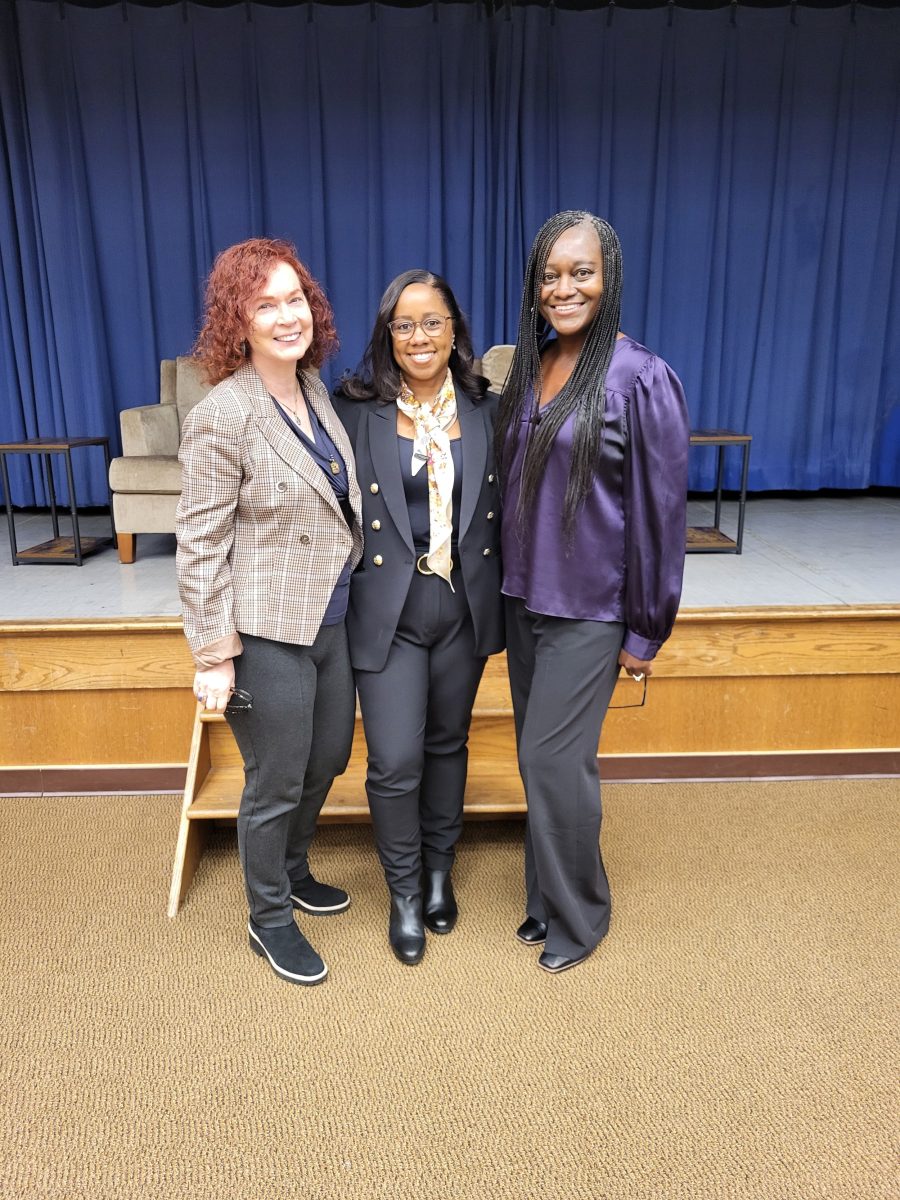Professors Lisa Merrill (left) and Veronica Lippencott (right) were proud to welcome Anjuliet Woodruffe (middle) back to Hofstra University. // Photo courtesy of Veronica Lippencott.
The feelings of home and familiarity come to the surface through various thoughts and emotions. The emotional experience associated with defining home may range from a particularly warm feeling of safety to a specific smell, place or individual. Without a doubt, the meaning of home differs for each person.
Anjuliet G. Woodruffe, a postdoctoral fellow at the Charles Phelps Taft Research Center at the University of Cincinnati, defines home as a space. On Thursday, Nov. 2, Hofstra’s Africana Studies Program and the department of writing and rhetoric presented “Reimagining Home as a Space, not Place.” This event featured Woodruffe’s autoethnographic research to redefine the meaning of home from a transnational feminist framework.
This momentous occasion was also marked as a period in Woodruffe’s academic career that has come full circle. Woodruffe received her undergraduate and graduate degrees from Hofstra University and taught as an adjunct faculty member before receiving her doctorate from the University of South Florida.
Lisa Merrill, a writing studies and rhetoric professor, described this remarkable homecoming in her introductory remarks as she recalled being Woodruffe’s mentor and watching her blossom into the scholar she is today.
“Under the African American philosophy of ‘each one, teach one,’ I have been influenced by the wonderful work [Woodruffe] has done as a student as well as a colleague,” Merrill said.
Woodruffe theorized home as a space from a transnational feminist framework. According to Woodruffe, the term transnational characterized her dual citizenship as a Trinidadian by birth and American through naturalization and her mobility across territorial, social and aesthetic borders.
Furthermore, it encompassed her “intersectional set of racialized class and gendered understandings and practices that speak to me about my experience as an immigrant other in the United States,” Woodruffe said.
Throughout her presentation, Woodruffe examined the concept of home in relation to its affective entanglement on diasporic bodies. She shared her immigrant experience and how that impacted her understanding of home as a space, not a place. When Woodruffe first started her academic career as an international undergraduate student from Trinidad, she struggled with “nowhereism,” which can be described as the “sense that I don’t feel attached to any one place because I have no real roots there,” Woodruffe said.
She described that being away from Trinidad, the only home she had known until that point of her life, created a dissonance related to loss, including the “loss of cultural connections, interpersonal connections and loss of social support.” Emotional dissonance becomes heightened due to the need to adjust to new places with different values, beliefs, traditions and customs.
As Woodruffe recounted her struggles with her dual identity and definition of home, she explained that individuals are connected to places through sensory responses. “How we respond to space is more ambiguous, yet specific to the individual based on their knowledge and experience of a place,” Woodruffe said.
Moreover, Woodruffe contextualized her definition of home as a space with the theories of other autoethnographers and sociologists. While sociologist Stuart Hall argued that we are products of the routes we have taken, Woodruffe claimed that rootedness guides how we engage. “My attachments to home travel with memory so intensely that, like Sarah Ahmed says, the physical sense of moving through space is enough to trigger a memory of another place,” Woodruffe said. For Woodruffe, this occurred each time she traveled through the subway and heard someone playing the steel pan, reminding her of her home in Trinidad.
Ultimately, Woodruffe concluded, “Although I can adapt to new ways of being, home as an essential state of being, traveling as interiority and [the] recreation of the home is an ongoing subjective process of reconstructing familiarity and safety while simultaneously adapting, acculturating and figuring out how to assimilate.”
Woodruffe concluded with a critical poetic autoethnography in the form of a bio poem to narrate her experiences as a transnational woman living in a space between two lands.
As Woodruffe read her bio poem, the audience sat mesmerized as they reflected and connected with the words that Woodruffe used to describe the struggles, victories and lessons she learned throughout her life.
“My favorite part of the event was her bio poem,” said Tatyana Hudson, a junior drama major and a history and educational studies minor. “It was the most memorable because she was vulnerable and open.”
Woodruffe’s bio poem also inspired feelings of affinity as audience members connected with her Trinidadian roots. Rhean Bellille, a junior criminology major, redefined her understanding of home in light of what Woodruffe shared. “A place of home is a space where memories lie, the feeling of comfort is captured and being able to be one’s self is a main feeling,” Bellille said.
Hofstra faculty members also connected to Woodruffe’s research. Veronica Lippencott, an adjunct associate professor of global studies and geography and director of Africana Studies, viewed Woodruffe’s theory of home as a space through a geographic lens. “One of the important concepts in human geography is [a] ‘sense of place.’ It is the emotions someone attaches to an area based on their experiences,” Lippencott said. “Place can be applied at any scale and does not necessarily have to be fixed in either time or space. Dr. Woodruffe uses the terms “space” and “place” a little differently than a geographer, but the essence is the same.”
Recently, Woodruffe and Merrill collaborated to research links to Edmonia Lewis, a nineteenth century Black and Native American sculptor who received national and international acclaim. Woodruffe and Merrill’s work is still ongoing as they research Lewis and other aspects of Black history and the diaspora.








